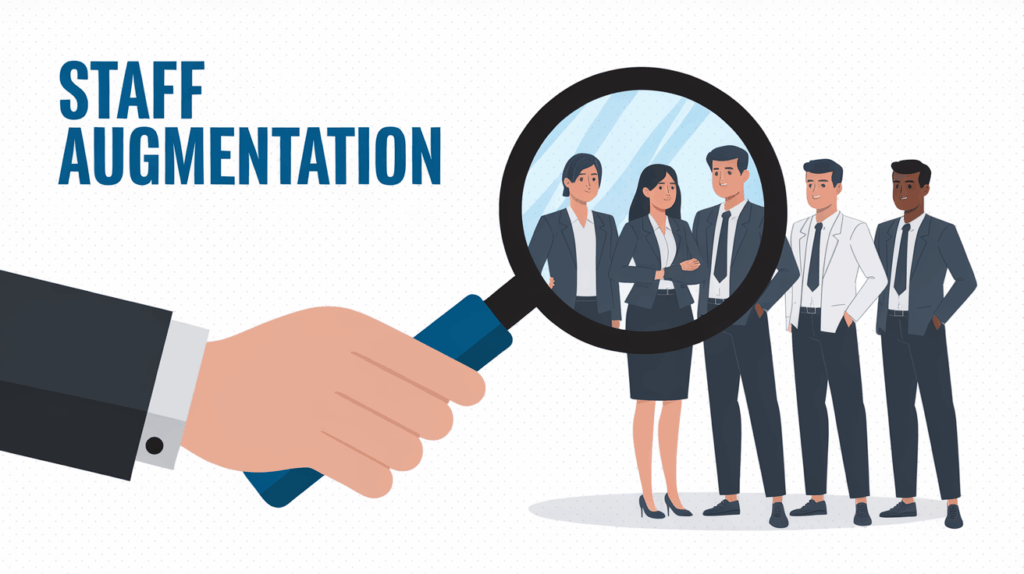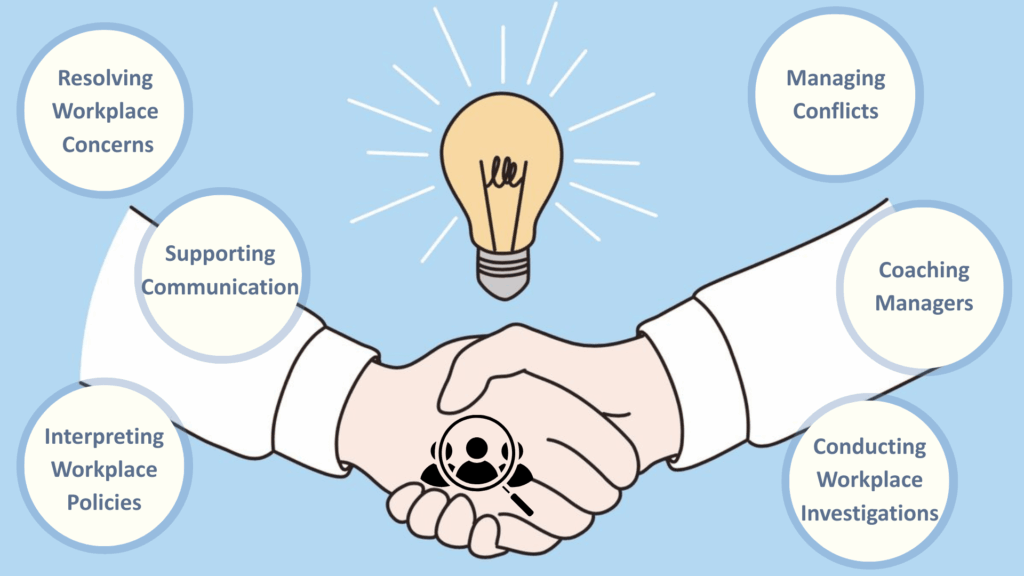What Is Staff Augmentation?
Definition:
Staff augmentation means adding external professionals to your existing team to meet short-term or project-specific goals while retaining control over work and outcomes.
Staff augmentation is a workforce strategy where businesses hire external professionals to support their in-house teams for a specific period or project.
Instead of hiring new employees permanently, companies bring in qualified experts who work under their management, just like internal staff, to fill temporary or skill-based gaps.
It’s often used when a company needs specialized talent, short-term support, or a fast project turnaround.
Whether it’s software development, marketing campaigns, or accounting projects, staff augmentation gives organizations immediate access to professionals who can integrate smoothly into their operations.
Why Companies Use Staff Augmentation?
Businesses turn to staff augmentation when they need talent fast but don’t want the overhead of permanent hires.
The approach is especially valuable in industries where demand fluctuates or expertise changes rapidly.
Technology, healthcare, engineering, marketing, and finance are the top sectors using staff augmentation to meet project deadlines and maintain efficiency.
Globalization and remote work have also played a major role in its rise.
Today, organizations can hire professionals across borders, building hybrid teams that work seamlessly from anywhere.
Ultimately, the model gives businesses something traditional hiring can’t: speed, control, and scalability.
Key Benefits of Staff Augmentation
1. Rapid access to talent
Organizations can find skilled professionals almost immediately. This reduces downtime between project planning and execution.
2. Flexibility to scale
Staff can be added or reduced as project requirements shift. This allows companies to stay agile and manage resources efficiently.
3. Reduced hiring costs
Recruitment, onboarding, and employee benefits often cost more than short-term contract arrangements. Augmentation minimizes these expenses.
4. Retained control
Unlike outsourcing, the company still manages workflow, priorities, and performance. The external professionals follow internal processes.
5. Specialized expertise
Businesses gain access to professionals with niche skills not available in-house, enhancing overall project quality.
6. Faster delivery
Since augmented staff are pre-vetted and experienced, projects progress faster and more efficiently.
Challenges of Staff Augmentation
| Challenge | Description | Solution / Mitigation |
|---|---|---|
| Short onboarding period | External professionals need time to understand company workflows, which can slow progress initially. | Plan an efficient onboarding process with clear documentation and internal support to help them get up to speed quickly. |
| Communication gaps | Remote or offshore teams may face time zone or language barriers, leading to collaboration issues. | Use overlapping working hours, communication tools, and regular check-ins to keep everyone aligned. |
| Dependency risks | Overreliance on external staff can reduce in-house skill development and create long-term dependence. | Maintain a balance by pairing external experts with internal team members to encourage knowledge transfer. |
| Compliance and security | Managing contracts, data privacy, and labor laws can be complex, especially for international hires. | Implement strict compliance policies, NDAs, and data protection measures while working with vetted vendors. |
How Does Staff Augmentation Work?
The process is straightforward but strategic. It focuses on matching business needs with the right professionals quickly and effectively.
1. Identify needs: Define the skills, experience level, and duration required. This ensures clarity before engaging any external talent.
2. Partner with a staffing provider: Businesses often work with agencies or consultancies that specialize in staff augmentation. These partners handle sourcing and initial screening.
3. Evaluate candidates: Professionals are vetted for technical expertise, reliability, and cultural fit. The goal is seamless integration into existing teams.
4. Onboard and integrate: Once selected, augmented staff are introduced to company systems, tools, and processes. They start working under the direct supervision of internal managers.
5. Manage and deliver: The organization maintains control over daily tasks and performance, while the staffing partner handles payroll, contracts, and HR compliance.
6. Offboard or extend: After the project ends, contracts can be concluded or renewed. In many cases, companies offer permanent roles to high-performing professionals.
This process gives businesses flexibility without the overhead of traditional hiring.
Types of Staff Augmentation Models

1. Onshore Staff Augmentation
This model involves hiring professionals within the same country.
It’s ideal for industries that require strict compliance, in-person collaboration, or real-time communication.
The main advantage is cultural and time zone alignment, though costs are generally higher.
2. Nearshore Staff Augmentation
Here, companies hire from nearby countries with similar time zones.
For example, U.S. firms might hire talent from Canada or Mexico. It’s a balance between cost savings and communication ease.
3. Offshore Staff Augmentation
This approach taps into global talent pools in regions like Asia, Eastern Europe, or South America.
It offers significant cost advantages and 24-hour productivity cycles but requires careful management to overcome time zone and cultural challenges.
Each model serves different business goals onshore for control, nearshore for collaboration, and offshore for cost efficiency.
Common Staff Augmentation Services and Models
Common staff augmentation services and models vary based on project scope, management needs, and legal structure.
Staffing agencies are a popular option, as they manage sourcing, vetting, payroll, and compliance while providing ready-to-deploy professionals for both short- and long-term roles.
This approach reduces administrative work and ensures quick access to qualified talent.
For smaller or highly specialized projects, freelance platforms offer a flexible solution by connecting businesses directly with freelancers.
These platforms are ideal for task-based work where companies can hire experts quickly without long-term commitments.
Another option is working with independent contractors, where companies engage skilled individuals directly for consulting or project-based roles.
This model offers strong flexibility and cost control but requires the business to handle contracts, payments, and compliance independently.
Finally, the Employer of Record (EOR) model is designed for companies expanding internationally.
The EOR serves as the legal employer for foreign staff, managing taxes, benefits, and compliance with local labor laws.
This allows businesses to build global teams without the complexity of setting up local entities.
Each service type differs in cost, legal framework, and management responsibility, allowing organizations to choose the model that best fits their operational and strategic needs.
Staff Augmentation vs Outsourcing
These two models often overlap but serve different purposes.
Staff Augmentation: The external professionals become part of your internal team. You manage their work, goals, and deliverables.
Outsourcing: The vendor takes full responsibility for project completion. You hand over the process and focus on results.
| Aspect | Staff Augmentation | Outsourcing |
|---|---|---|
| Control | Company retains management | Vendor manages work |
| Engagement | Integrated with internal team | Operates independently |
| Cost | Based on time or hourly rate | Usually fixed per project |
| Flexibility | High | Limited |
| Use Case | Expanding team temporarily | Delegating non-core functions |
Staff augmentation offers more control and transparency, making it ideal for companies that value internal oversight and alignment.
When Should a Company Use Staff Augmentation?
This model suits organizations facing changing workloads or needing quick access to skills they don’t have internally.
You should consider staff augmentation if:
- A major project requires more manpower than your current team provides.
- You need short-term expertise without permanent hiring costs.
- Hiring locally takes too long or exceeds the budget.
- Workloads fluctuate seasonally or by client demand.
- You want to expand globally without opening new offices.
It’s especially effective for growing businesses that want to stay lean yet capable of scaling at any moment.
Common Misunderstandings About Staff Augmentation
It’s only for IT.
While IT companies use it heavily, industries like finance, logistics, and marketing also rely on this model for flexibility.
It’s too expensive.
While hourly rates may seem high, total costs are lower when factoring in benefits, taxes, and recruitment expenses.
It replaces full-time staff.
Staff augmentation complements permanent employees. It strengthens teams, not replaces them.
It reduces control.
You maintain complete authority over operations and project management. The external professionals adapt to your internal systems.
Signs Your Business is Ready for Staff Augmentation
You may be ready for staff augmentation if:
- Projects are delayed because of limited resources.
- Recruitment costs and timelines are growing.
- Specialized skills are missing in your current team.
- Workload fluctuates during growth or expansion.
- Your company plans to operate in new regions without a local base.
Recognizing these signs early allows you to respond strategically instead of reactively.
Conclusion
Staff augmentation has evolved into more than just a temporary staffing solution.
It’s a strategic workforce model that helps businesses stay agile, competitive, and efficient.
By combining internal teams with skilled external professionals, companies can scale quickly, control costs, and maintain quality.
By tapping into external talent, businesses can scale teams, access specialized skills, and complete projects efficiently without long-term hiring costs.
The key lies in using it wisely with clear goals, structured management, and the right partners.
In a world where speed and skill define success, staff augmentation offers exactly what modern organizations need: the right talent, at the right time, for the right outcome.
Do comment below your views on staff augmentation.










